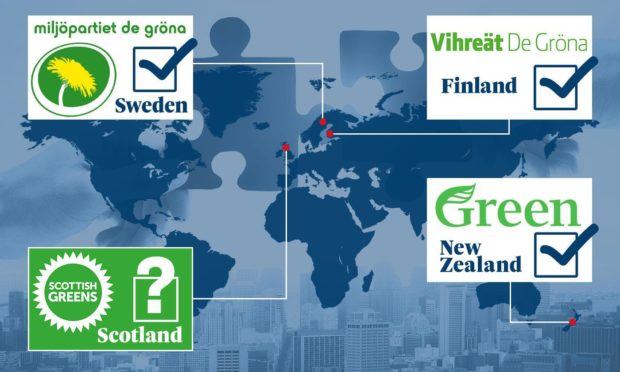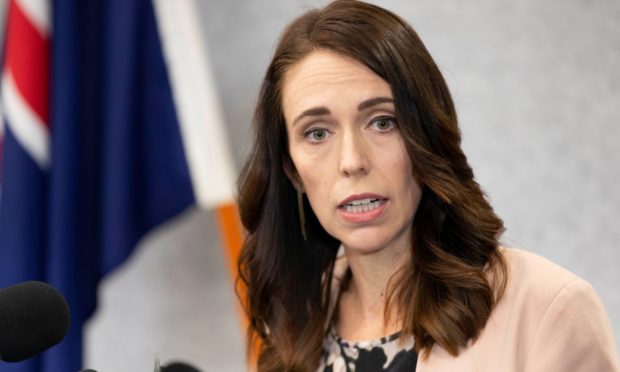The new political partnership between the SNP and Scottish Greens puts them in a power-sharing deal for the first time. It’s sparked a frenzied backlash from their political opponents – but what’s the reality of Greens in government?
The Scottish Conservatives have routinely labeled the Greens “extremists” in press releases and media interviews over the last few weeks.
“It is pure economic vandalism to hand power to Green MSPs” Conservative MSP Murdo Fraser said recently, calling the Greens “radicals”; while conservative journalist and commentator Andrew Neil branded them “eco-zealot Marxists” in his Daily Mail column.
But the rise in popular support for the Greens at May’s Holyrood election mirrors a similar ‘green wave’ across northern Europe in the last few years with parties seeing their support increase in The Netherlands and Germany, while in Finland, Sweden and Austria they’ve joined coalition governments.
Having greens in power in Finland in particular is nothing new, as they’ve shared power in various coalitions for 16 of the last 26 years.
During that time Finland has routinely placed at or near the top of lists like the Reporters Without Borders’ World Press Freedom index; the World Economic Forum’s Gender Gap study; the United Nations’ World Happiness Report; Transparency International’s Least Corrupt Countries index; and came dead last (again) in the latest Fragile States Index – meaning it’s considered the world’s most stable nation: none of which are typical hallmarks of ‘extremism’.
“The Greens in Finland have quite long history of working in government coalitions. We joined a government coalition for the first time in 1995 and have been in several coalitions since” explains Maria Ohisalo, the leader of the Finnish Greens – Vihreät – and currently the Interior Minister, equivalent to Home Secretary in the UK.
Finland’s green foreign minister is Pekka Haavisto, a popular former United Nations bureaucrat who came second in the last two presidential elections, and having senior ministers in the government lets the greens push their own policy priorities while at the same time forces them to work responsibly in partnership with the other four coalition members.
“All parties have their own positions and goals and we all have to come together and reach a compromise. For us, the ability to work in various kinds of coalitions has enabled us to reach many of our goals in the past decades” says Maria Ohisalo.
And although the party has traditionally focused on an environmental agenda, Ms Ohisalo says this is only the starting point for the things her party wants to achieve in government.
“Just transition is one of the cornerstones of our thinking: we need to implement ambitious environment and climate policies that are also fair to different demographics – while further strengthening the welfare state, reducing inequality and creating jobs in green solutions.”
Greens in government in Sweden and New Zealand
The Swedish green party – Miljöpartiet de Gröna – found itself in a government coalition for the first time seven years ago, although they’ve had representation in parliament for more than 30 years.
While the party’s main policy platforms remain focused on fighting the climate crisis, they also have initiatives around equality, democracy and human rights.
New Zealand’s centre-left government, under Prime Minister Jacinda Ardern, has a partnership deal with the greens that was the blueprint for the SNP-Green deal in Scotland.
And just like in Scotland the NZ Greens have two junior ministers in government, and handle portfolio subjects that are important to them and their voters.
“The Greens can make some policy gains in crucial areas to their ideology. In this case on family violence, housing, and climate change” explains Dr Lara Greaves, who teaches politics at the University of Auckland in New Zealand.
“Fundamentally, the purpose of being in politics is meant to be to make policy change or make the world a better place. Ultimately, the deal provided an opportunity for the Greens to try to make some policy gains in areas important to their voters” she adds.
Demonising the Greens? Sounds familiar
When Britain was still in the European Union, SNP MEPs worked closely with green politicians at the European Parliament as part of the Green-European Free Alliance group.
Finnish Green MEP Ville Niinistö says he was quite used to cooperating with the SNP in Brussels, and it seems natural they would build a partnership with the Greens in Scotland too.
Niinistö, a former Green party leader himself, says the way the Scottish Greens are being labeled follows a familiar pattern.
“I became a member in the year 2000 in the second wave of green support, but the first people in the 80s and 90s were labeled as all kinds of extremists or eco-terrorists or whatever, and that is usually one way for established political supporters or populists to push you down and give the population a sense that there’s risks involved with a new political group.”
Niinistö says when greens become more prevalent a local council and national level in his home country” the anti-Green rhetoric changed.
“It becomes about the issues, when the other parties see that labeling them as extremists doesn’t get a reaction from the voters.”



